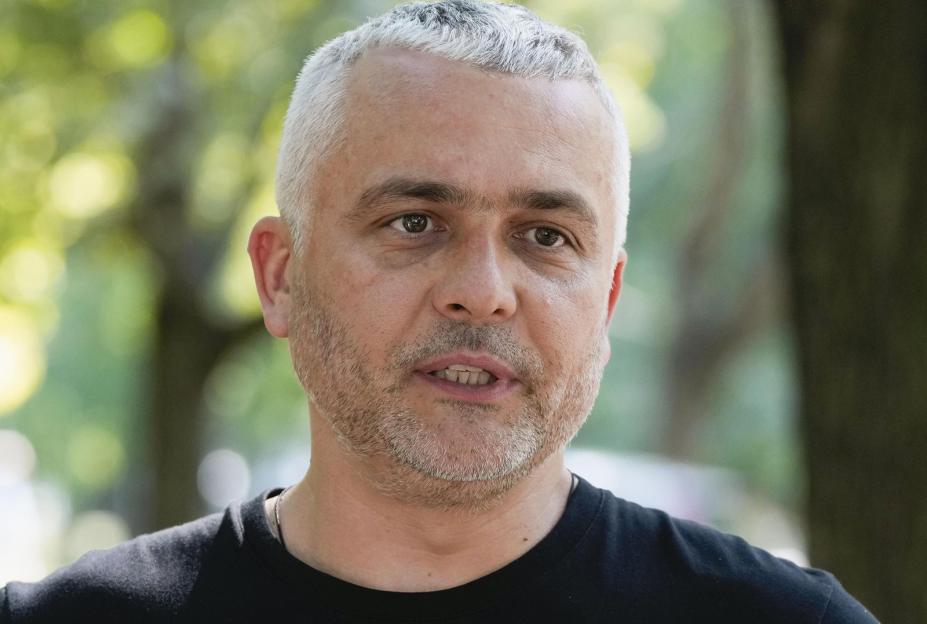Russian warships were still launching attacks on Ukraine following the claim from Kyiv that the commander of Moscow’s Black Sea Fleet was killed Friday, as President Volodymyr Zelensky praised the arrival of US Abrams tanks to the country.
A spokesperson for the Ukrainian Navy said on national television Monday that while Russia was still launching strikes from the Black Sea, he compared the operations to “a chicken running around without a head.”;
“At this moment, they (the Russian Navy) lost the person who actually manages all of this, and his staff, who manages the fleet together with him. This is a large grouping that requires a great number of managers to run all the processes to make it (the fleet) work as a single mechanism. Imagine that the core part of this mechanism becomes inoperable,”; said Ukraine navy spokesperson Dmytro Pletenchuk.
Pletenchuk said Russian President Vladimir Putin “does not control the actual operation of ships at sea”; and relies on his admirals who know “their means and forces, personnel, how to manage them, how to better deploy them.”;
“Therefore, as of now, they will have respective problems with the control of the troops,”; he said.
Pletenchuk’s comments came after the Ukrainian Special Operations Forces claimed Russian Adm. Viktor Sokolov, as well as 33 other officers, were killed in the attack on the Black Sea headquarters in Sevastopol Friday, in perhaps the boldest attack by Ukrainian forces on the occupied peninsula of Crimea so far.
More than 100 other Russian servicemen were wounded in the special op dubbed “Crab Trap,”; which was timed to strike while senior members of Russia’s Navy were meeting, Special Operations Forces said.
CNN cannot independently confirm Ukraine’s claims about Solokov or the number of casualties. CNN has reached out to the Russian defense ministry for comment.
Moscow has said that one serviceman is missing as a result of Ukraine’s attack on Sevastopol.
Ukraine has increasingly been hitting strategic Russian targets in Crimea, the Black Sea region of southern Ukraine that has been occupied by Moscow since 2014. Ukraine has not given up hope of reclaiming it.
Ukrainian Defense Intelligence spokesperson Andrii Yusov said Russia was using Crimea as a “logistics hub”; and that “the ultimate goal, of course, is the de-occupation of Ukrainian Crimea.”;
Abrams arrive
Western weapon supplies have played a key role in helping Ukraine’s vastly outgunned forces defend against Russian assaults as well as conduct their own longer range attacks beyond the front lines.
That has infuriated Moscow and over the weekend Russian foreign minister Sergei Lavrov accused the United States and others are “directly at war with us.”;
In the latest arrival of key weaponry, the first batch of US Abrams tanks arrived in Ukraine, the Pentagon and Zelensky confirmed Monday.
“The mere presence of Abrams tanks serves as a potent deterrent. By having these tanks in their arsenal, the Ukrainian army can more effectively discourage aggressive actions,”; Pentagon spokesman Maj. Charlie Dietz said Monday.
The tanks are a long-awaited capability for Ukraine and adds a powerful ground component to troops who have already endured more than a year and a half of war.
President Zelensky said the tanks were “getting prepared to reinforce our brigades.”;
The US began training Ukrainian forces on how to operate the tanks in May in Germany. The 31 tanks destined for Ukraine had been undergoing refurbishment and preparation for shipment for several months, and were officially approved to be transferred last month.
Attacks on port infrastructure
Following the Ukrainian strike on Sevestopol Friday, a wave of Russian attacks hit the southern Ukrainian port city of Odesa overnight on Monday and Tuesday, Ukrainian officials said.
Attack drones targeted Odesa for over two hours in the early hours of Tuesday, hitting port infrastructure in Izmail district, according to Oleh Kiper, head of Ukraine’s Odesa regional military administration.
It comes a day after Russian strikes killed at least two people and caused “significant damage”; to the city, Kiper said. One of the victims was found under the rubble of a warehouse where grain was stored, he said.
Ukraine’s military alleged Russia’s attack on Odesa was a violation of international humanitarian law, as it targeted both troops and civilian infrastructure, including the power supply. The defense forces also said the attack was a “pathetic attempt at retaliation”; for the strike on Russia’s Black Sea Fleet headquarters.
Monday’s attack damaged the city’s port and power infrastructure, as well as granaries, warehouses and several private households in the suburbs of the city, Ukraine’s Prosecutor General’s Office said.
Ukraine’s energy minister said Monday that about 1,000 consumers were without electricity and that a “large-scale repair campaign”; was under way.
Russian forces employed Iranian-made drones, hypersonic missiles, cruise missiles and a submarine in the assault, Ukraine’s defense forces said. Nineteen drones and 11 missiles were shot down.
The debris from the downed weapons damaged some warehouses and private homes and while the granaries were damaged in the hypersonic missile strike.
When asked to comment on the Odesa attacks, Kremlin spokesman Dmitry Peskov directed questions to the Russian Ministry of Defense to talk about “specific military operations.”;
Moscow’s forces have repeatedly targeted the southern port following the collapse of the Black Sea grain deal in July, that allowed Ukrainian ships to bypass a Russian blockade of Ukrainian Black Sea ports and navigate safe passage through the waterway to Turkey’s Bosphorus Strait in order to reach global markets.
Many of the world’s poorer nations are heavily reliant on Ukrainian grain and Russia has been accused of weaponizing the threat of global hunger throughout the war against its neighbor.
Russian forces also bombarded the nearby region of Kherson – a major shipbuilding industry by the Black Sea – with attacks killing at least six people and wounding five on Monday, Ukrainian officials said.
A 73-year-old man and a 70-year-old woman were among those killed after Russian forces dropped four bombs on the southern Ukrainian city of Beryslav, according to Oleksandr Prokudin, head of the Kherson regional military administration.
Over the past day, Russian forces launched 87 attacks on the Kherson region, Prokudin said, hitting residential areas, medical buildings, educational institutions, and critical infrastructure.
Civilians have fled the intense Russian shelling and only one fourth of population remains in Beryslav, according to Prokudin.
“Over the past two weeks, almost 100 children and their families have left the dangerous coastal communities”; of Kherson region, he said.





